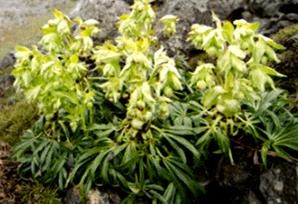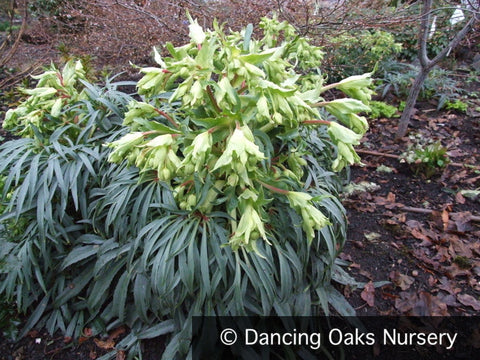Stinking Hellebore (Helleborus foetidus), also known as Bearsfoot Hellebore, Dungwort, Setterwort, Stinking Hellebore, or Stinkwort, is an evergreen perennial belonging to the Ranunculaceae family. Native to the mountainous regions of Europe, Greece, and Asia Minor, this plant is well-known for its unique appearance and hardiness.
Growing up to 61 cm tall, stinking hellebore features light green, finely divided foliage and fragrant, yellowish-green cup-shaped flowers that bloom from winter to spring. Its leaves emit an unpleasant odor when crushed, which explains its common name. The plant grows in a weeping form, making it an eye-catching addition to any garden.
Ideal for semi-shady locations, stinking hellebore thrives in rich, well-drained soil, making it a great choice for gardeners looking for a low-maintenance perennial with year-round appeal.
| Common name | Bearsfoot Hellebore, Dungwort, Setterwort, Stinking Hellebore, Stinkwort |
| Botanical name | Helleborus foetidus |
| Family | Ranunculaceae |
| Species | foetidus |
| Origin | mountainous regions of Europe, Greece and Asia Minor |
| Life cycle | Perennial |
| Plant type | Herbaceous Perennial |
| Hardiness zone | 5, 6, 7, 8, 9 |
| Sunlight | Dappled Sunlight |
| Maintenance | Low |
| Soil ph | Alkaline |
| Drainage | Well-Drained |
| Flowering period | Spring |
| Height | 1 ft. – 2 ft. |
| Flower color | Cream, Tan |
| Leaf color | Green |
| Stem color | Green |
| Flower benefit | Long-lasting |
| Garden style | Shade Garden |
| Uses | Naturalized Area |
I. Appearance and Characteristics
Helleborus foetidus, known variously as stinking hellebore , dungwort, setterwort and bear’s foot, is a species of flowering plant in the buttercup family Ranunculaceae, native to the mountainous regions of Central and Southern Europe and Asia Minor. It is found wild in many parts of England, especially on limestone soil.
It is an evergreen perennial growing to 80 cm (31 in) tall and 100 cm (39 in) across, with a thick succulent stem and glossy leaves. The drooping cup-shaped flowers appear in spring, and are yellowish-green, often with a purple edge to the five petal-like sepals on strongly upright stems.

The flowers, typically for the family, contain numerous stamens as well as up to ten nectaries which make them attractive to bees and other insects. Each flower produces up to five (usually three) wrinkled follicles. Despite its common name, it is not noticeably malodorous, although the foliage is pungent when crushed.
All parts of the plant are poisonous, containing glycosides. Symptoms of intoxication include violent vomiting and delirium.
Yeasts colonise the nectaries of stinking hellebore and their presence has been found to raise the temperature of the flower, which may aid in attracting pollinators to the flower by increasing the evaporation of volatile organic compounds. It was the first species in which this effect was discovered.
H. foetidus is grown in gardens for its handsome evergreen foliage and large numbers of green, bell-shaped flowers borne in late winter. It prefers woodland conditions with deep, fertile, moist, humus rich, well-drained soil, and dappled shade. The species is, however, drought-tolerant. It often occurs naturally on chalk or limestone soils.
This plant has gained the Royal Horticultural Society’s Award of Garden Merit.
The cultivar ‘Green Giant’ has very bright green flowers and finely divided foliage; ‘Miss Jekyll’ has fragrant flowers, intensity varying with the time of day; ‘Wester Flisk Group’ has red-tinted leaves and stems and gray-green flowers; the ‘Sierra Nevada Group’ is dwarf, reaching 30 cm.

Propagation is by division or from seed, which can be prolific, naturalising well in ideal conditions. Rodents should be kept away from the garden since they deprecate the seeds either when still in fruiting plants within the carpels or from the floor after seed release.
II. How to Grow and Care
Sunlight
Stinking hellebore is shade-tolerant; receiving 3 hours of light a day is preferable. Scattered or low light, even during growth, is sufficient. Planted near deciduous shrubs or trees, the foliage provides shade to it in spring and summer, while the bare branches do not block the weaker sunlight in fall and winter.
If you plant stinking hellebore in containers, shade it or move it to a cooler place in summer; otherwise, the leaves may turn yellow. If you place it on the balcony in winter, it can receive light throughout the day to improve the quality of future flowers, since long periods without light lead to weaker branches and thus, no blooms.
Temperature
Stinking hellebore prefers shade. The optimum temperatures for growth are 10 to 15 ℃. It can resist colds down to-35 ℃ degrees in winter. It goes semi-dormant during summer heat. As a moisture lover, it cannot tolerate either drought nor waterlogging.
Watering

Thriving in its native European woodland settings, stinking hellebore is well-adapted to periods of moisture followed by dry spells. This species exhibits a preference for consistent moisture but can tolerate short-term drought due to its resilient nature. Watering should be carried out every week to maintain optimal hydration levels.
Typically grown outdoors, stinking hellebore has a notable ability to withstand cold temperatures, which influences its water uptake and contributes to its hardiness as an evergreen plant.
Soil
Fertile, well-drained sandy soil is optimal for stinking hellebore. The appropriate soil pH is 6.5-7.5: more or less neutral. It can survive in poor soil, but adequate nutrients promote growth and bloom. If the soil is poor, improve it by mixing in potting soils or organic fertilizers.
Fertilizing
To boost stinking hellebore’s health, apply balanced nutrition fertilizer biannually – during early spring and midsummer. This regimen promotes vibrant growth and luscious blooms, fortifying plant vigor. For young stinking hellebore, light feedings are preferable, while mature plants thrive with a moderate quantity.
Over-fertilization risks harm; thus, adhering to label instructions is crucial. Engage slow-release fertilizers for prolonged nourishment and avoid application near the plant’s base to prevent root burn.
Pruning

Stinking hellebore is an evergreen plant that often retains old leaves in late winter when new leaves sprout. Cut off some of the older leaves after the new ones have sprouted. This not only keeps it aesthetically pleasing, but also helps control pests and diseases due to dense foliage.
Remove withered flowers from the base promptly after flowering to help concentrate the nutrients to leaves. The sap of stinking hellebore can cause skin irritation, so wear gloves when pruning. After pruning, wash the shears and gloves.
Propagation
Stinking hellebore propagates best from cuttings during spring and summer. Propagation is generally easy, with visible signs of success indicated by new shoots. Keep the cuttings moist and ensure indirect sunlight for optimal growth.
Transplanting
Stinking hellebore can be ideally transplanted during the sweet spot between mid to late spring. This allows the plant to establish its roots before summer arrives. Choose a partly shaded location with well-draining soil, and be gentle while handling delicate root balls, if needed.
Repotting
Repot your stinking hellebore every 2-3 years to accommodate its growth, with the best time being after winter dormancy. As a non-climbing bush with upright growth, stinking hellebore thrives in a slightly larger pot that supports extensive root development. Choose well-draining containers and provide post-repotting care including shade, moderate watering, and avoid over-fertilizing. Happy repotting for robust, healthy stinking hellebore!
III. Uses and Benefits

The evergreen stinking hellebore, with its long dark green-and-blue leaves, is most appreciated for its ability to self-propagate into an attractive ground cover in shady areas. It is also suitable for the ‘filler’ element in container arrangements, especially when paired with tall, colorfully blooming plants in shades of purple or yellow.
IV. Harvesting and Storage
Collect seeds in early summer when the fruit has turned brown, mature, dry, and hard. Wear gloves to avoid skin irritation when collecting the seeds. You can also collect seeds by covering the flowers with a paper bag while the fruit is still green, and waiting for the fruit to ripen and crack. Stinking hellebore seeds are best sown right after harvesting, so they’ll be ready to sprout late that winter.
The life span of cut stinking hellebore flowers is related to the variety. Usually flowers of light-colored varieties only last 1-2 days after harvesting, while some dark purple varieties can last up to a week. Cut at the middle or bottom of the flower stem to keep some scape. It’s best to cut the flowers in the early morning after the flowers fully bloom.
Find Where to Buy the Best Stinking Hellebore (Helleborus foetidus)


















Leave a Reply